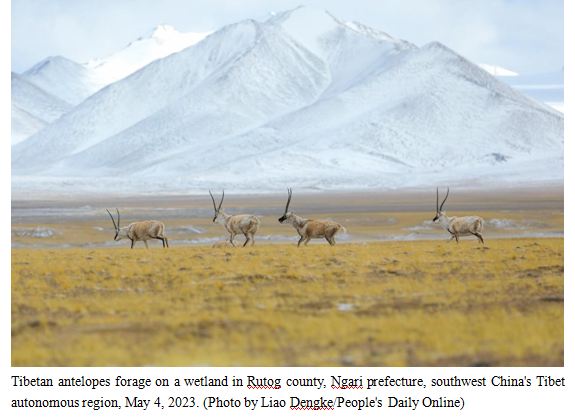By Ping Lun
China is one of the most biodiverse countries in the world. It has two national botanical gardens, the China National Botanical Garden in Beijing and the South China National Botanical Garden in Guangzhou, south China’s Guangdong province, which serve as the country’s biodiversity conservation bases, reserves of strategic plant resources and important platforms for botany communication.
The two national botanical gardens play a vital role in the protection of biodiversity and mirror China’s firm resolution and concrete actions to turn Earth into a beautiful and biodiverse homeland.
The China National Botanical Garden is home to over 17,000 plant species, including nearly 1,000 rare and endangered ones. In particular, it has introduced 24 species of spruce from across the world, more than half of all the varieties in the world. “Niche” plants in the botanical garden, including the Chinese fringetree, beauty bush and cornus kousa, have become popular in the botanical garden these days.
More than 2,000 kilometers away, the South China National Botanical Garden has introduced more than 1,100 plant species since 2022. It now houses a total of over 17,500 conservative plant species, ranking among the top five globally.
Biodiversity makes Earth full of vigor and vitality, and lays the foundation for human survival and development. Protecting biodiversity helps protect Earth, the homeland shared by all, and contributes to humanity’s sustainable development.
China has made unprecedented efforts to advance ecological progress and attached high importance on biodiversity conservation in recent years .
It has continuously strengthened biodiversity mainstreaming, applied a system of ecological conservation red lines, established a protected areas system with national parks as the mainstay, carried out major biodiversity protection projects, and conducted most stringent enforcement and supervision. A large number of rare and endangered species have been placed under effective protection, and the diversity, stability and sustainability of the ecosystem have kept improving. The country has found a path of biodiversity protection with Chinese characteristics.
The Chinese path to modernization is a process of modernization of harmony between humanity and nature. Respecting, adapting to, and protecting nature is essential for building China into a modern socialist country in all respects.
In 2021, an epic trek of an herd of wild Asian elephants from southwest China’s Yunnan province attracted global attention. Recently, new information about these animals has been released. The elephants are healthy and new members have joined the herd, known as the “short-nose family.” It has split into two groups and explored different areas.
While the number of Asian elephants is on a decline globally, the expanding population of them in China marks a signature achievement of the country in ecological progress and biodiversity conservation.
Besides, the status of wild giant pandas in China has been downgraded from “endangered” to “vulnerable,” and the population of crested ibises, a rare bird species, has increased from seven in 1981 to more than 9,000 at present. Today, it’s not rare anymore to see the migration of Tibetan antelopes or Yangtze finless porpoise swimming in the river.
These stories exactly indicate the new progress made by China in biodiversity conservation.
The conservation of biodiversity calls for higher social awareness and participation. A documentary about China’s ecological progress titled No Poverty Land II – A Treasure Trove was aired on multiple streaming platforms. Many those who watched it were moved. They commented that sustainable development is the real path to a “no poverty land.” Millions of people are working in this country to safeguard the splendid nature. Their stories are also encouraging more people to learn and participate in biodiversity conservation.
China has established a long-term mechanism that draws wide participation from enterprises, public institutions, social organizations and the public, which nurtures a sound environment and strengthens citizens’ consciousness for biodiversity conservation.
Today, China is still facing challenges in biodiversity conservation. To reverse biodiversity loss remains a daunting task that needs to be completed with joint efforts and immediate actions.
China will continue to modernize its biodiversity governance system and capabilities, and will work to improve natural ecosystems and provide more eco-environmental products to achieve a virtuous cycle of natural ecosystems. It is believed that the country will definitely meet people’s growing demands for a beautiful environment



















